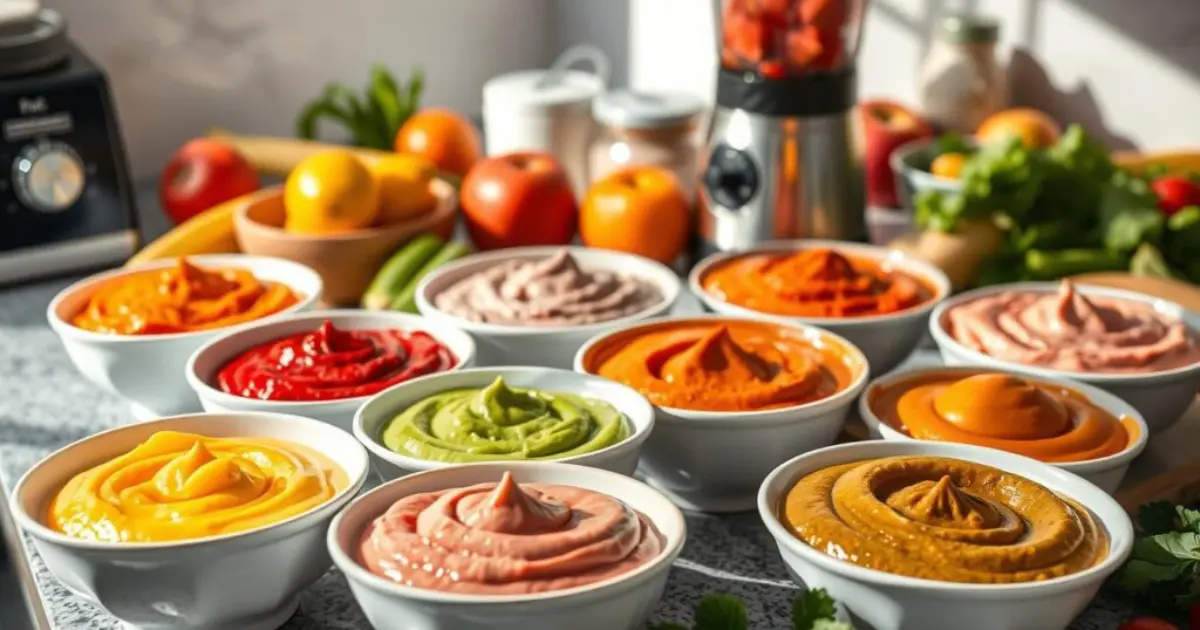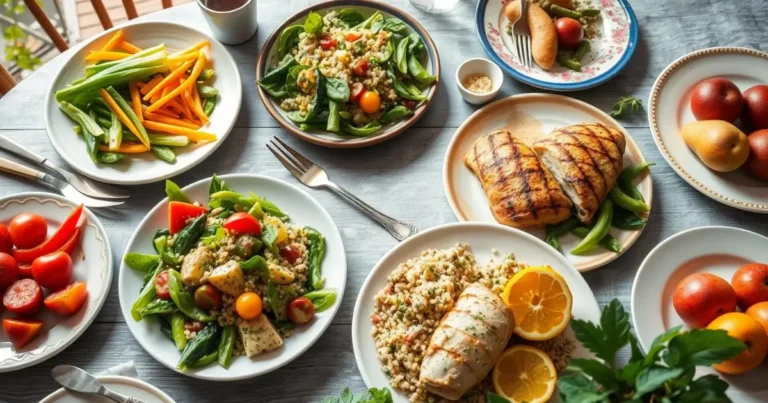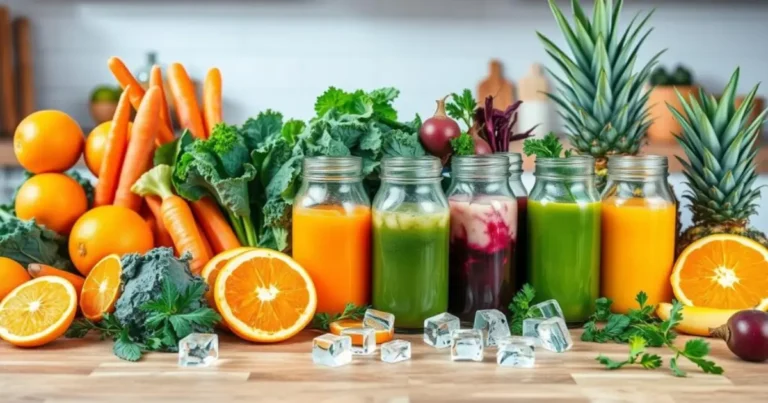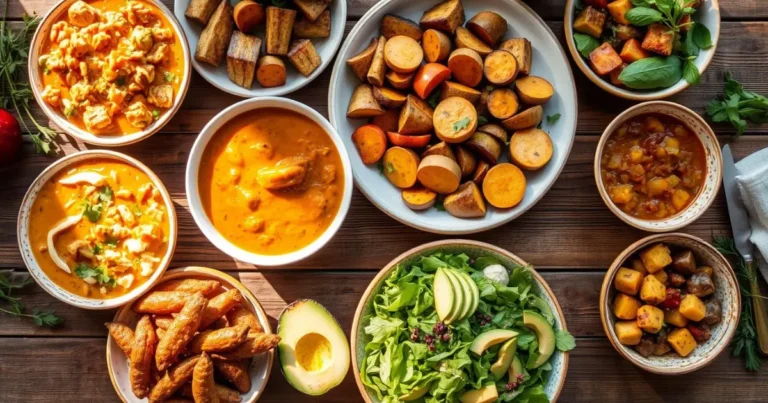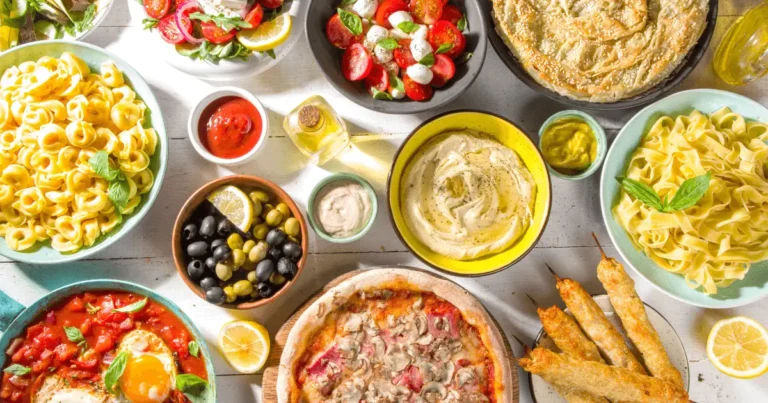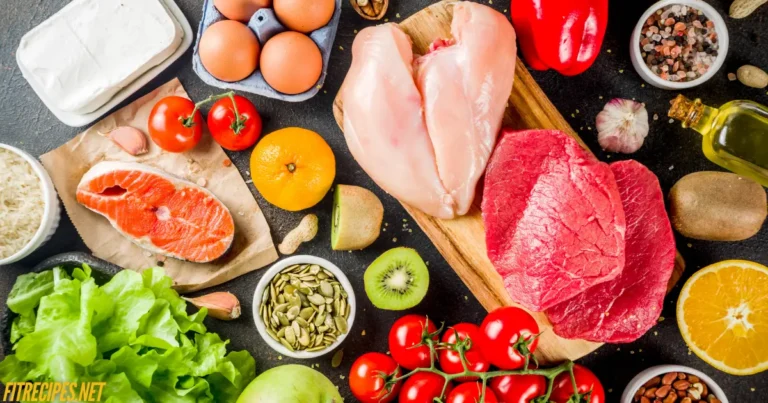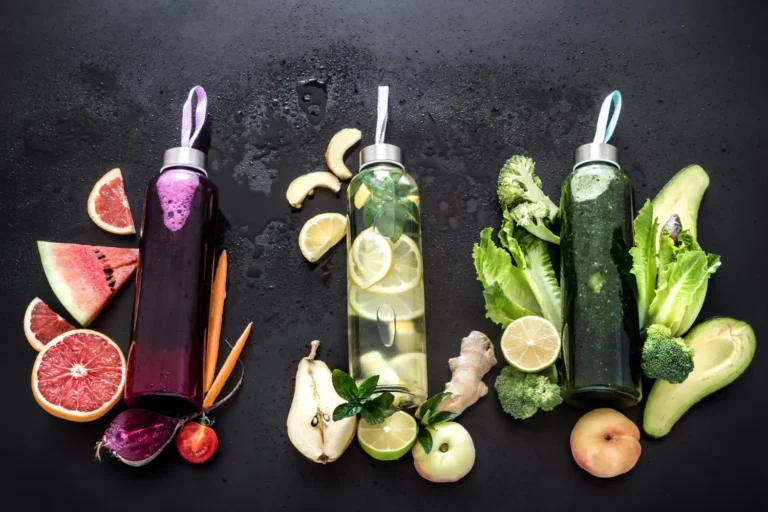Nutritious Pureed Diet Recipes
Thinking about adding pureed diet recipes to your meals? You might be curious about the benefits of pureed food for adults. Does it really offer the nutrients and taste needed for a satisfying meal?
With the right recipes, you can make tasty and healthy meals that fit your needs. Pureed food isn’t just for those with health issues. It’s also great for anyone wanting to make meal prep easier and enjoy smooth, easy-to-digest meals.
Table of Contents
Key Takeaways
- Pureed diet recipes can provide essential nutrients for improved health
- Pureed food for adults can be a convenient and easy-to-digest option
- Incorporating pureed diet recipes into your meal plan can enhance mealtime satisfaction
- Pureed food for adults can cater to various dietary needs and restrictions
- With the right recipes, pureed diet recipes can be delicious and flavorful
Understanding Pureed Diet Basics
Exploring pureed foods means learning about a pureed diet. It’s made of recipes pureed foods that are smooth and easy to eat. This diet helps those who can’t chew or swallow solid foods well.
Understanding pureed diet basics is key. A good pureed diet includes foods rich in nutrients. It’s important to have a variety of foods to get all the vitamins and minerals needed.
- Protein sources, such as lean meats and legumes
- Complex carbohydrates, like whole grains and fruits
- Healthy fats, including nuts and avocados
Knowing the basics of a pureed diet helps ensure you get the nutrients you need. It’s good for your health, whether you’re caring for someone or managing your own diet.
What Defines a Pureed Diet
A pureed diet is smooth and easy to eat. It’s made by blending foods in a blender or food processor. It’s often suggested for people with health issues or after surgery.
Who Benefits from Pureed Foods
Pureed foods help many people, like the elderly, babies, and those with health problems. They’re easy to eat and digest, perfect for those with dietary needs.
Nutritional Considerations
When planning a pureed diet, think about the nutrients. Make sure it has enough protein, carbs, fats, and vitamins. This ensures a balanced diet.
| Nutrient | Recommended Daily Intake |
|---|---|
| Protein | 0.8-1.2 grams per kilogram of body weight |
| Complex Carbohydrates | 45-65% of total daily calories |
| Healthy Fats | 20-35% of total daily calories |
Essential Kitchen Equipment for Pureeing Success
To make pureed food, you need the right kitchen tools. A blender or food processor is essential. They can handle different ingredients like fruits, veggies, meats, and grains. Think about the size and power of the machine and the purees you want to make.
Some popular kitchen equipment for pureeing includes:
- Blenders: Ideal for making smooth purees, such as soups or sauces.
- Food processors: Great for chopping and pureeing larger quantities of food.
- Immersion blenders: Perfect for pureeing soups or other liquids right in the pot.
You might also want a fine-mesh strainer or a sieve for the right consistency. The right kitchen equipment makes making pureed foods easy and fun. With practice and patience, you’ll soon be making tasty and healthy purees.
| Kitchen Equipment | Use |
|---|---|
| Blender | Making smooth purees |
| Food Processor | Chopping and pureeing larger quantities of food |
| Immersion Blender | Pureeing soups or other liquids right in the pot |
Mastering the Art of Pureeing Food
Exploring puree recipes for adults means learning the basics. You need to know how to make tasty and safe meals. This includes getting the right texture, following food safety rules, and adjusting flavors to your liking.
Food safety is key when making purees for adults. You must handle and store ingredients right. Cook food to the right temperature and refrigerate or freeze purees quickly to avoid spoilage.
Proper Consistency Guidelines
Getting the perfect consistency is important for tasty purees. Use blenders or food mills to adjust the texture. For a smooth puree, blend cooked veggies with a bit of liquid. For a thicker puree, use less liquid or a food mill.
Food Safety Tips
To keep purees safe, follow these steps. Refrigerate or freeze them quickly. Label and date containers. Reheat purees to the right temperature before eating.
Texture Modification Techniques
Changing textures can make your purees more interesting. Try adding herbs or spices to change the taste and feel. Also, use different cooking methods like roasting or grilling to get unique flavors and textures.
| Puree Recipe | Consistency | Food Safety Tip |
|---|---|---|
| Vegetable Puree | Smooth | Refrigerate promptly |
| Fruit Puree | Thick | Freeze for later use |
Best Pureed Diet Recipes for Breakfast
Starting your day with a nutritious meal is key. Pureed foods are a great choice for breakfast. You can make a variety of best pureed foods like fruit smoothies, protein-rich dishes, and warm breakfast purees. These meals use ingredients like oats, eggs, and yogurt to give you energy.
Popular breakfast purees include banana and avocado smoothies, egg and cheese purees, and oatmeal with fruit. Adding nuts, seeds, or honey can enhance flavor and nutrition. Choose fresh, high-quality ingredients for the best taste and nutrition.
Here are some tips for making tasty and healthy pureed breakfast meals:
- Use a variety of fruits and vegetables to add natural sweetness and flavor to your purees.
- Experiment with different spices and seasonings to give your purees a unique taste.
- Consider adding a source of protein, such as eggs or yogurt, to keep you full and satisfied until lunchtime.
By following these tips and using best pureed foods in your breakfast, you can start your day with a nutritious and delicious meal.
Nourishing Lunch and Dinner Purees
Exploring pureed diet recipes for lunch and dinner reveals many options. These meals are both nourishing and tasty. They include vegetables, lean proteins, and whole grains, making them easy to digest.
For lunch, you can make cream-based soups like broccoli or cauliflower. Blend them with chicken or turkey for extra protein. Try pureed vegetable mixes, like carrot and ginger or spinach and garlic, as sides or recipe bases.
Dinner purees can mix proteins like chicken or fish with carbs like quinoa or brown rice. Adding spices and herbs boosts flavor. Here are some ideas:
- Pureed chicken and vegetable stew
- Quinoa and black bean bowl with pureed salsa
- Baked salmon with pureed sweet potato and green beans
Creating tasty pureed meals is all about trying new ingredients and flavors. Don’t hesitate to experiment and adjust to your liking.
Creating Flavorful Vegetable Purees
Exploring pureed diets means learning to make tasty vegetable purees. It’s not just about blending veggies. You must pick the right veggies, think about their natural tastes, and add seasonings. You can use one veggie or mix them for different flavors and textures.
Start with single veggies like carrots, zucchini, or sweet potatoes. Each has its own taste that you can boost with seasonings. For instance, carrots taste sweeter with a bit of salt and pepper. Mixing veggies creates complex tastes by blending different flavors.
Single Vegetable Purees
- Carrots: Sweet and earthy, carrots pair well with ginger and cinnamon.
- Zucchini: Light and refreshing, zucchini can be seasoned with basil and lemon juice.
- Sweet Potatoes: Nutty and sweet, sweet potatoes are enhanced by paprika and garlic powder.
Mixed Vegetable Combinations
Mixing veggies opens up a world of flavors. Combining broccoli, cauliflower, and carrots makes a tasty, healthy puree. The right seasonings are key to enhancing these mixes. Turmeric and lemon juice, for example, can make broccoli and cauliflower purees pop.
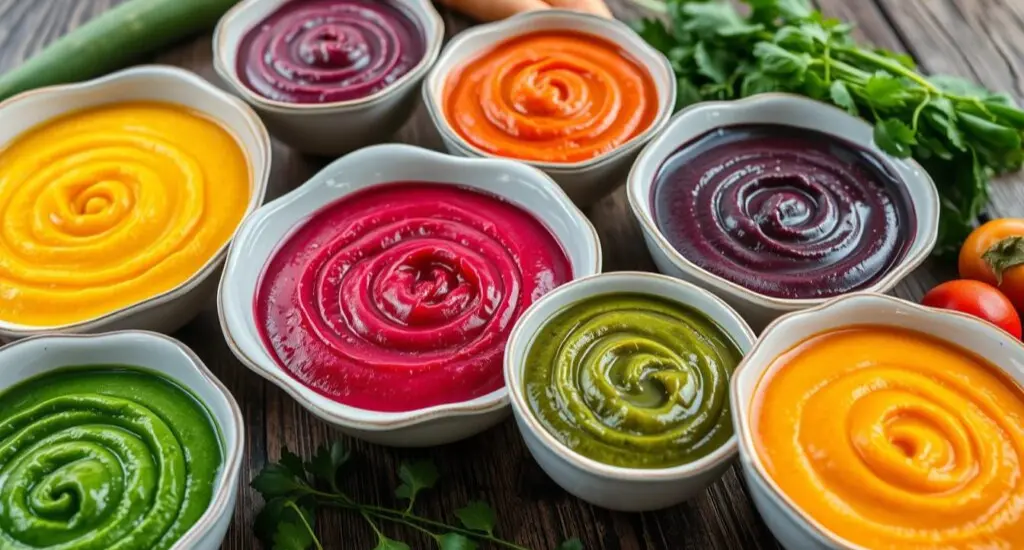

Seasoning Guidelines
Seasoning is crucial for tasty vegetable purees. Herbs and spices add depth, while lemon juice brightens the taste. Start with a little seasoning and adjust to taste. This way, you can enjoy a variety of healthy meals.
Mastering flavorful vegetable purees opens up a world of delicious, healthy meals. Whether using single veggies or mixes, remember to season well to bring out the best flavors.
| Vegetable | Seasoning Suggestions |
|---|---|
| Carrots | Ginger, cinnamon, salt, and pepper |
| Zucchini | Basil, lemon juice, garlic powder |
| Sweet Potatoes | Paprika, garlic powder, salt, and pepper |
Protein-Rich Pureed Recipes
When you look into pureed diet recipes for adults, focus on high protein options. This is key to meet your nutritional needs. You can find protein in meats, fish, eggs, and even plant-based foods like legumes and tofu.
Here are some protein-rich pureed recipes:
- Chicken and vegetable puree
- Lentil and spinach puree
- Salmon and sweet potato puree
These recipes not only add protein but also vitamins and minerals.
When making protein-rich purees, think about what adults need nutritionally. Try mixing different ingredients to make tasty and healthy pureed diet recipes.
Adding protein-rich purees to your diet helps you get the nutrients you need. Whether you’re searching for pureed diet recipes for adults or just want more protein, these recipes are a great starting point.
Making Pureed Foods More Appealing
When it comes to making pureed food appealing, presentation is key. You can make your meals look great by using creative plating. Try using a piping bag for fun designs or add fresh herbs for color.
It’s not just about taste; it’s about the whole dining experience. Adding garnishes like edible flowers or microgreens can make meals elegant. This makes mealtime fun, even for those on a pureed diet.
Here are some tips to make pureed foods more appealing:
- Use different colors on the plate for interest
- Add texture with toppings like crushed nuts or seeds
- Make patterns with sauces or pureed foods
To enhance flavor, use herbs and spices. This can make your meals more enjoyable. By combining creative plating with flavorful ingredients, you can make pureed foods more appealing.
| Plating Technique | Description |
|---|---|
| Garnishing with fresh herbs | Adding a sprinkle of fresh herbs, such as parsley or basil, to the plate for a pop of color and flavor |
| Creating patterns with sauces | Using sauces, such as marinara or alfredo, to create patterns on the plate and add visual interest |
Storage and Meal Prep Solutions
Storing pureed food right is key to keeping it fresh and safe. Use airtight containers to keep meals fresh longer. You can also portion meals in individual containers for easy grab-and-go.
Freezing is a great choice for longer storage. Always follow freezing guidelines to avoid bacterial growth. Label containers with date and contents, and store at 0°F (-18°C) or below.
Freezing Guidelines
- Label containers with the date and contents
- Store containers in the freezer at 0°F (-18°C) or below
- Use airtight containers to prevent freezer burn
Portioning meals is another smart prep solution. It makes reheating simple and saves time. Plus, it cuts down on food waste.
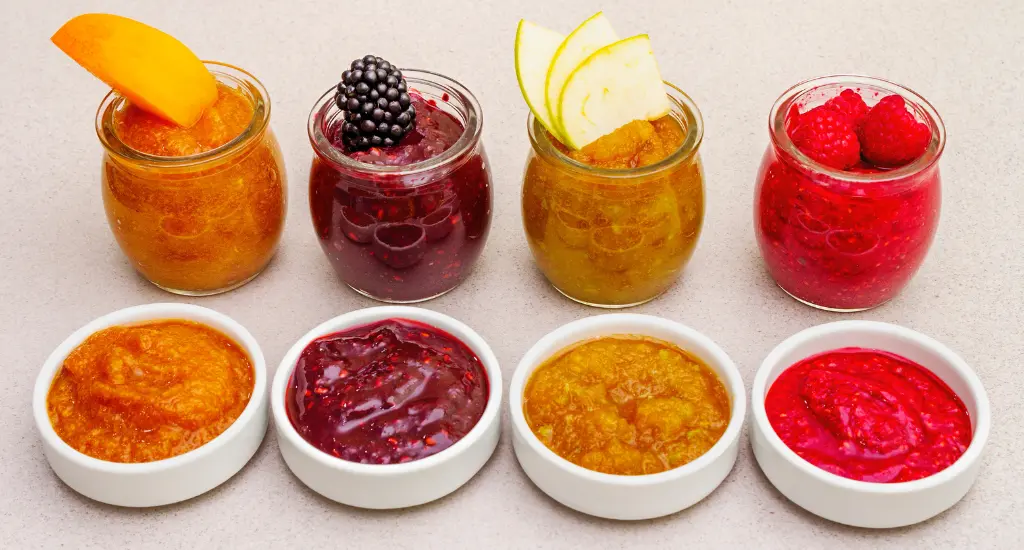

Reheating Instructions
Safe reheating is crucial to avoid foodborne illness. Use the microwave or oven. Make sure the meal heats to 165°F (74°C).
Addressing Common Pureed Diet Challenges
Following a pureed diet can be tough, with many challenges at mealtime. One big issue is texture aversions, which are hard for adults to get used to. Pureed food for adults changes how food feels and tastes.
To beat these challenges, focus on keeping your diet balanced and eating safely. This is key for those with dysphagia. Here are some tips to help you face common pureed diet challenges:
- Start with small amounts of pureed food and slowly add more as you get used to it.
- Try different flavors and seasonings to make pureed food more enjoyable.
- Get help from a healthcare professional or registered dietitian to plan meals that are right for you.
Also, be careful about food safety and avoid choking hazards. By planning and preparing meals carefully, you can have a safe and healthy pureed diet.
Remember, your health is important when you’re on a pureed diet. With the right approach, you can handle common challenges and keep your diet balanced and nutritious.
| Challenge | Solution |
|---|---|
| Texture aversions | Gradually introduce pureed food into your diet |
| Nutritional balance | Consult with a healthcare professional or registered dietitian |
| Food safety | Take steps to prevent choking hazards and follow proper food handling procedures |
Special Dietary Considerations for Pureed Foods
When it comes to pureed foods, it’s key to think about special dietary needs. You might need gluten-free or dairy-free options because of dietary restrictions or preferences. Luckily, there are many choices to meet these needs.
Gluten-Free Options
Gluten-free pureed foods can be made with ingredients like rice, quinoa, and corn. You can also use gluten-free flours to thicken soups and sauces. Examples include banana puree and avocado puree.
Dairy-Free Alternatives
Dairy-free options are also easy to find. You can use non-dairy milk like almond, soy, or coconut milk for creamy soups and sauces. Examples include fruit smoothies and vegetable purees.
By considering these special dietary needs, you can enjoy a wide range of tasty and healthy pureed foods. Whether you need gluten-free or dairy-free options, there are plenty of choices to fit your needs.
Conclusion: Making the Most of Your Pureed Diet Journey
Starting your pureed diet journey is more than just eating. It’s a chance to try new, tasty, and beautiful pureed recipes. Be open to trying different ingredients, spices, and textures. Your taste buds and body will love it.
Getting used to a pureed diet might take some time. But with the right tools and a bit of creativity, you can make delicious meals from simple ingredients. Keep working towards your health goals, and let this guide help you.
The secret to a great pureed diet is finding a balance between healthy and tasty food. Enjoy every bite and feel good about feeding your body well. Bon appétit, and enjoy your delicious pureed diet journey!
FAQ
What defines a pureed diet?
A pureed diet includes foods that are blended or mashed into a smooth texture. It’s good for people who can’t chew or swallow well. This includes the elderly, babies, and those with certain health issues.
Who typically benefits from a pureed diet?
Many people can benefit from a pureed diet. This includes: – Older adults with dental problems or trouble swallowing – Babies and young kids starting solid foods – People recovering from surgery or illness – Those with conditions like stroke, Parkinson’s, or cancer that make swallowing hard
What are the nutritional considerations for a pureed diet?
It’s key to get enough nutrients on a pureed diet. You can do this by: – Eating a variety of pureed fruits, veggies, proteins, and grains – Adjusting how much you eat because pureed foods are more concentrated – Adding supplements or fortified foods if needed
What kitchen equipment is essential for pureeing food?
You’ll need some important tools for pureeing food. These include: – A strong blender or food processor – An immersion blender – A fine-mesh strainer or sieve – A ricer or potato masher – Spatulas and spoons for mixing and moving the puree
How do I achieve the proper consistency for pureed foods?
Pureed foods should be smooth and creamy. To get this right, you should: – Blend the food until it’s silky and even – Add liquids like broth or milk to get the right consistency – Strain the puree through a fine-mesh sieve if it’s still lumpy
What food safety tips should I keep in mind when preparing pureed foods?
Food safety is crucial when making pureed meals. Here are some tips: – Use fresh, quality ingredients and avoid spoiled foods – Clean and sanitize all your equipment – Store pureed foods in airtight containers in the fridge or freezer – Reheat pureed foods well to kill bacteria
How can I make pureed foods more appealing?
You can make pureed foods look better by: – Presenting them nicely on the plate – Adding garnishes like herbs or nuts – Trying different flavor combinations
How should I store and reheat pureed foods?
Proper storage and reheating are important for pureed foods. Here’s how: – Put pureed foods in single-serve containers and refrigerate or freeze them quickly – Freeze them in ice cube trays or small containers for easy reheating – Reheat slowly and stir often to keep the texture right

